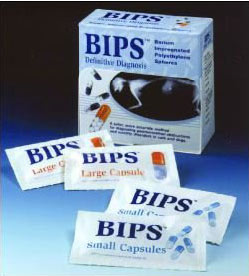| Is it a G.I. Obstruction or something else? |
BIPS® are an easy, economical way to make an in-clinic diagnosis without some of the problems commonly experienced when using liquid barium.
When your client shows up with a vomiting pet, you know the reason could be many things…including a gastrointestinal obstruction.
Increasingly, veterinarians are discovering that BIPS (barium impregnated polyethylene spheres) are a safe, convenient way to detect if a total, partial or linear obstruction is the cause.
Within 24 hours, you’ll have more evidence to diagnose the problem by using the two-step approach:
Day #1 – Provide a tentative diagnosis of the animal and as long as the pet is stable, and survey films are not diagnostic, prescribe appropriate supportive care along with a dose of BIPS.
Day #2 – Follow up to determine if the patient’s condition has resolved. If so, ask the client to look for BIPS spheres in the pet’s stool, along with monitoring for recurrence of symptoms. If not, repeat x-rays to help you detect a blockage and provide some clues as to where it’s located.
|
|
 |
| Advantages of BIPS® |
 |
| • Less time consuming |
| • Easy oral administration in the form of capsule(s) |
| • Fewer x-rays required |
| • X-rays taken at your schedule's convenience |
| • A safe alternative when aspiration is a concern |
| • A cost-effective option when finances are limited |
|
| "They are neater, easier, in my opinion safer and as diagnostic as liquid barium. Cheaper and less time consuming too." - Stephanie S. DVM |
|